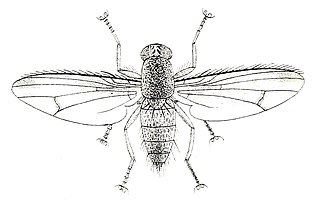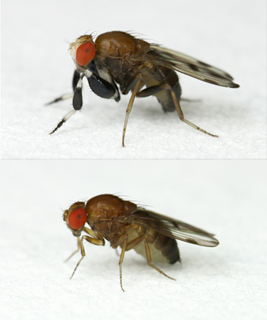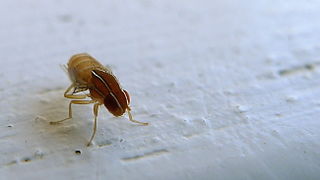
The Drosophilidae are a diverse, cosmopolitan family of flies, which includes fruit flies. Another unrelated family of flies, Tephritidae, also includes species known as "small fruit flies". The best known species of the Drosophilidae is Drosophila melanogaster, within the genus Drosophila, and this species is used extensively for studies concerning genetics, development, physiology, ecology and behaviour. This fruit fly is mostly composed of post-mitotic cells, has a very short lifespan, and shows gradual aging. As in other species, temperature influences the life history of the animal. Several genes have been identified that can be manipulated to extend the lifespan of these insects. Additionally, Drosophila subobscura, also within the genus Drosophila, has been reputed as a model organism for evolutionary-biological studies.

The Drosophilinae are the largest subfamily in the Drosophilidae. The other subfamily is the Steganinae.
The paraphyletic subgenus Sophophora of the genus Drosophila was first described by Alfred Sturtevant in 1939. It contains the best-known drosophilid species, Drosophila melanogaster. Sophophora translates as carrier (phora) of wisdom (sophos). The subgenus is paraphyletic because the genus Lordiphosa and the species Hirtodrosophila duncani are also placed within this subgenus.

The Curtotonidae or quasimodo flies are a small family of small grey to dark brown humpbacked flies (Diptera) with a worldwide distribution, but with very few species in the Nearctic, Australasian/Oceanian, and Palaearctic regions. Most members of the family are found in tropical to subtropical latitudes in Africa and the Neotropics. Many remain undescribed in collections, since little work on the family has been done since the 1930s.
The subgenus Siphlodora belongs to genus Drosophila and consists of two species that share a sigmoid-shaped posterior crossvein. Phylogenetically, the subgenus is positioned within the virilis-repleta radiation.

The genus Zaprionus belongs to the family fruit fly Drosophilidae and is positioned within the paraphyletic genus Drosophila. All species are easily recognized by the white longitudinal stripes across the head and thorax. The genus is subdivided in two subgenera, based on the presence of an even or odd number of white stripes. The species of the genus can be found in African and Southern Asia. One species, Zaprionus indianus, has invaded the New World.

Drosophila appendiculata is a large yellowish fruitfly found in Southern Chile and neighboring Argentina. The species is placed in its own unique subgenus, Chusqueophila, based on the presence of three partial cross-veins in the wing.
Afrotethina is a genus of beach flies in the family Canacidae. All known species are Afrotropical in distribution.
Drosophila elegans is a flower-feeding species of fruit flies, belonging to the family Drosophilidae. It is found in Taiwan and the Philippines in Asia.

Chymomyza is a genus of vinegar flies.
Drosophila tripunctata is a species of vinegar fly in the Immigrans-tripunctata radiation of the subgenus Drosophila.

Lordiphosa is a genus of fly in the family Drosophilidae.

Drosophila prolongata is a fly of the family Drosophilidae. This species is endemic to southeast Asia. Males of this species express one of most extreme reversed sexual size dimorphism in the Drosophilidae, making this species an interesting model organism for the study of sexual selection. Males also display remarkable copulation courtship behaviour.

Zaprionus tuberculatus is a member of the subgenus and genus Zaprionus, family Drosophilidae, and order Diptera. It is an invasive fruit fly that originated in Africa, but can also be found in Europe and Asia. The fly earned its common name, the "vinegar fly", because researchers frequently captured the species using vinegar traps. Z. tuberculatus was previously considered a strictly tropical fly, but evidence of invasion to nontropical regions such as Turkey has been shown.
Drosophila acanthomera is a species of insect in the genus Drosophila.
Drosophila acanthostoma is a species of fly in the genus Drosophila. It is found in Hawaii.
Drosophila acelidota is a species of fly in the genus Drosophila. It is found in Cameroon and the Republic of the Congo.
Drosophila asticta is a species of fly in the genus Drosophila. It is found in Cameroon and the Republic of the Congo.
Drosophila colobos is a species of fly in the genus Drosophila. It is found in Cameroon and the Republic of the Congo.







